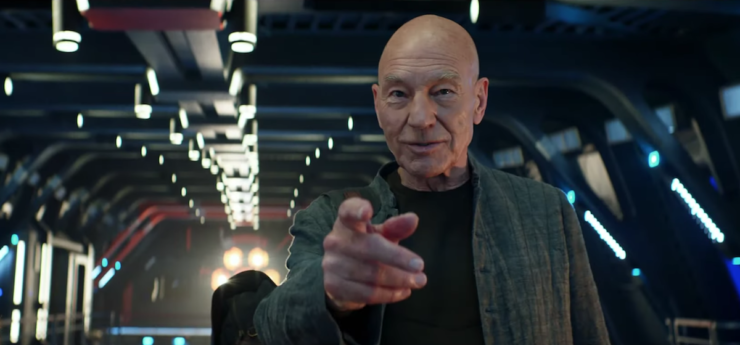It’s been a busy few months for geek TV between Baby Yoda fever, Watchmen blowing our collective minds, and The Witcher adaptation swinging swords and crooning songs. But January 23rd will deliver something new, something that carries a decades-long weight of hope, nostalgia, and reverie. Twenty-six years after Q told Jean-Luc Picard that he would “see you…out there” in the series finale of Star Trek: The Next Generation and 18 years after “a generation’s final journey” in Star Trek: Nemesis, Patrick Stewart’s stoic, compassionate, iconic fan favorite will finally return to TV screens, along with some new companions as well as some familiar faces.
Of course, that legacy comes with a lot of content to revisit. If you’re only looking at TNG, that’s 178 episodes across seven seasons as well as four feature films—and when you factor in Jeri Ryan’s Seven of Nine, she’s in three seasons of Star Trek: Voyager, and who knows what other established canon material will play into the new series… Even if you’re planning a full rewatch, you don’t have to squeeze all of it into the next couple of weeks; instead, you can follow this time-friendly guide to the key episodes and films that will bring you up to date just in time for the Picard premiere…
What We Know So Far
While there are a number of intriguing details available in the trailer for those willing to freeze-frame and dig for possible hints, this guide will stick to the basic premise as it’s been revealed so far—so let’s make a few basic assumptions about what we know, based on clear trailer details and press announcements:
- Picard has left Starfleet in a post-Nemesis, post-Star Trek (2009 Kelvin timeline film) world and is now on the family vineyard with an adorable dog.
- Before he left, he led some sort of rescue armada, the largest in Starfleet history. It seems reasonable to infer that this is about the destruction of Romulus.
- B4/Data is still in storage and Picard has lingering guilt over his sacrifice in Nemesis.
- The Borg are out there and still a threat.
- From the way she’s speaking, Seven of Nine has adapted to life after the Delta Quadrant. (A non-spoiler interview with Jeri Ryan reveals how she discovered Seven’s new voice after all these years.)
- From press appearances and discussions, Hugh the Borg is somehow involved.
The viewing recommendations below will be based on these points, so that means skipping things like Tasha Yar’s death, Q’s various shenanigans with Picard’s love life, Spock and Sarek in TNG, etc. Those are all certainly worth revisiting, but this guide will stay focused on what appears most relevant to the new series.
TNG Episodes
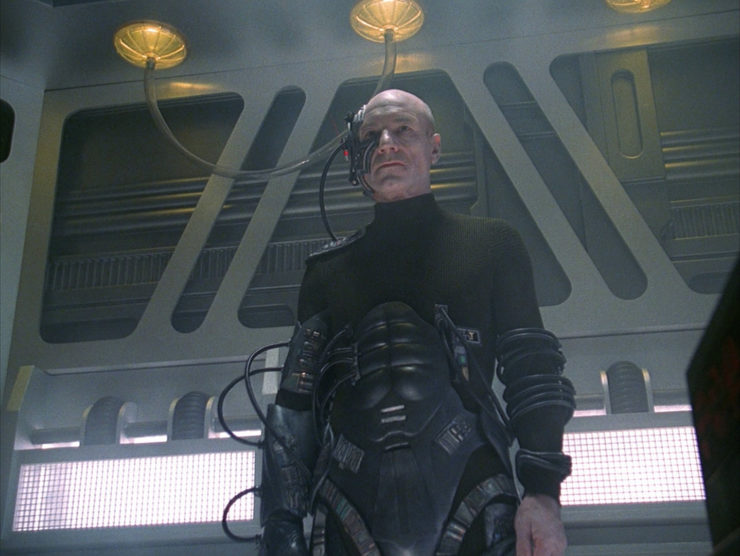
“Q Who”
The Star Trek world’s introduction to the Borg comes because Q is fed up with Picard’s hubris about the perseverance of humanity. Q snaps his fingers and sends the Enterprise-D to Borg territory, bringing about the moment of their encounter years before it should have happened, ultimately leading Picard to reframe Starfleet’s place in the galaxy while having the humility to ask Q for help.
“The Measure of a Man”
TNG’s first season treated Data as a bit of comic relief, given his fish-out-of-water personality and technological prowess. However, questions of his own identity—and his quest to become more human—consumed much of the series after that, with Picard leaning on Data often as a valuable ally and close friend. “The Measure of a Man” puts Data’s rights as an individual on trial, with Picard defending him. In addition to being one of TNG’s finest episodes, “The Measure of a Man” demonstrates the depth and importance of Data to Picard and the crew.
“The Best of Both Worlds,” Parts 1 & 2
In what may be the defining moment of Picard’s life, “The Best of Both Worlds” sees him captured and assimilated in one of the greatest season-finale cliffhangers in TV history. Despite the series remaining almost completely episodic, the scars of Picard’s assimilation are touched upon numerous times, even in Deep Space Nine and Voyager. In addition to Picard’s situation, this pair of episodes provides a lot of background regarding how the Borg operate, travel, communicate, and fight, all of which will likely be foundational for the upcoming series.
Buy the Book
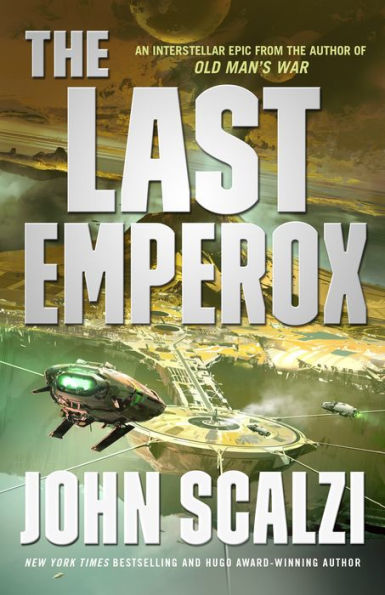

The Last Emperox
“Family”
“Family” deals specifically with Picard’s PTSD after the Locutus incident while also introducing the family winery, his brother Robert, and his nephew René. While the PTSD story is woven into the narrative, the episode also dives deep into the Picard family history and why Jean-Luc ditched the family business to go to the stars. The distance he put between himself and winemaking is significant, and the fact that he returns to the vineyard after Starfleet carries a lot of weight.
“I, Borg”
Can a Borg separate from the Collective? This question of identity works well as a bookend to the issues discussed in “The Measure of a Man.” This episode addresses the complexities of identity while also introducing us to Hugh, the Borg named by Geordi who begins to develop individuality. Hugh will be featured in the upcoming series, though the level of his involvement is unknown. However, one interesting point that may be explored is how Picard had an opportunity to send an invasive program to disable the Borg, yet chose not to because of Hugh…
“Starship Mine”
While this episode is completely standalone, it showcases Picard in the role of a take-charge action hero. Given how Star Trek: Discovery has incorporated high-stakes action into the show on a level that simply wasn’t possible during the TNG era, it seems reasonable that the Picard cast may see similar sequences (we’ve already seen trailer shots of Seven of Nine with a rifle). While Picard is the ultimate diplomat, there have been flashes of him in physical combat before, and this is a fun episode playing off his ingenuity and grit in those types of circumstances.
“Descent,” Parts 1 & 2
This pair of episodes, which concluded the sixth season and started the seventh season, effectively finish off a number of storylines that coalesce together: Data’s “brother” Lore, Data and his emotions, Hugh the Borg, and Borg encounters (at least until the film First Contact). In Descent, a group of rogue Borg led by Lore aims to destroy the Federation, all while Lore exploits Data’s tactical knowledge by harnessing the potential of his emotions. Much of this feels like it is prime for revisiting within Picard, particularly the final resolution with Hugh.
The Films
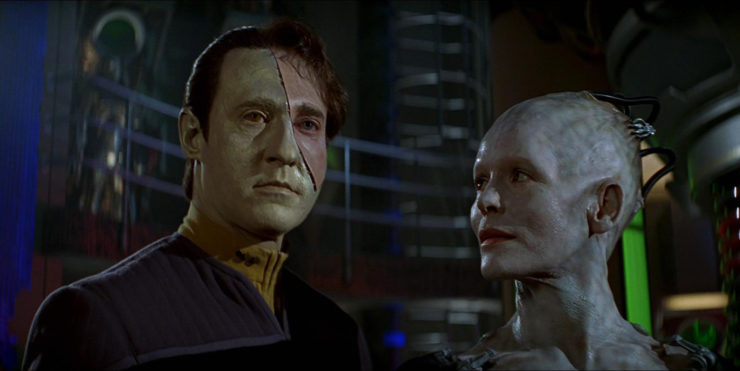
Generations (1994)
While Generations has nothing to do with the Borg, it has a huge impact on the Picard family by killing off Robert, René, and Maria (offscreen), leaving Jean-Luc to consider his legacy and connection to the family. There’s no doubt that this will create lingering feelings to be explored throughout the upcoming series. And while it’s a secondary plotline, the film dives deeper into Data as he explores and struggles to control his emotions thanks to a permanent fusing of his emotion chip.
First Contact (1996)
In what might be Patrick Stewart’s finest performance as Picard, this film provides a fun time-travel twist to the Borg story while also examining Picard’s PTSD with a degree of depth that hadn’t been seen since “Family.” The Borg hierarchy, with its operations under the Borg Queen (played by the delightfully evil Alice Krige), gets a further look, though First Contact invests more in Picard’s emotional journey than in Borg worldbuilding. As the TNG films focused closely on the friendship between Picard and Data, Data’s capture and attempted assimilation into the Borg—and what Picard is willing to sacrifice in order to rescue him—provides an opportunity to really explore their relationship.
Nemesis (2002)
The final TNG film spends most of its time focused on duality, centering on Picard and his clone Shinzon (played by a young Tom Hardy), and Data and his prototype B-4. However, significant plot points regarding the TNG family are laid out, including the marriage of Riker and Troi and their eventual departure to lead the USS Titan. The key moment, both for the franchise and for Jean-Luc Picard on a personal level, is Data’s sacrifice to rescue his captain at the end of the film. During the trailer for Picard, this sacrifice is discussed and will surely have significant emotional resonance within the series.
Star Trek (2009)
While the Kelvin-timeline Trek films don’t touch TNG, they contain two events that will likely carry over into the new series: the destruction of Romulus (which may the rescue operation referred to in the trailer) and the loss of Ambassador Spock. Spock is not mentioned in either Picard trailer, though his appearance in TNG was important so it’s safe to assume there will be some ripple effect on Picard’s psyche—especially considering that he mind-melded with both Spock and his father, Sarek.
Voyager Episodes
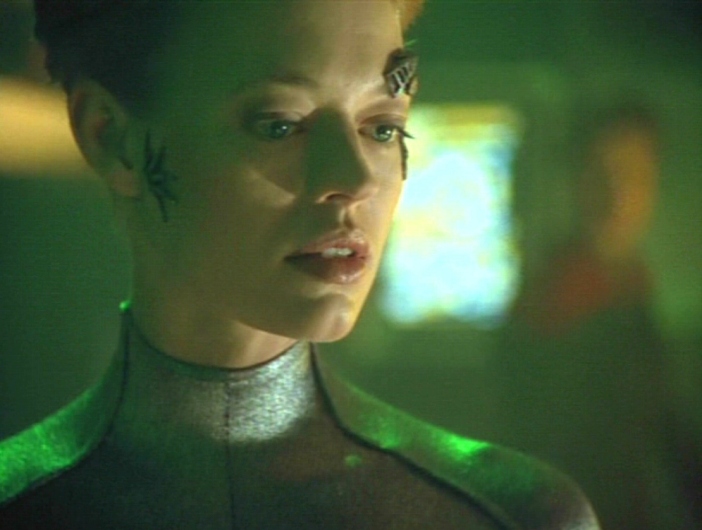
“Scorpion,” Parts 1 & 2
A true highlight of Voyager, not only does this set of episodes introduce Seven of Nine, it showcases the inner workings of the Borg in previously unseen circumstances: as prey, as a partner, and as a negotiator. Because the Voyager crew is forced to work with the Borg, internal processes such as decision making, repair, and engineering are revealed.
“The Gift”
In Seven of Nine’s first proper episode, she fiercely defies the realities of her new life despite her body rejecting its Borg implants after being severed from the Collective. This story kicks off Seven of Nine’s arc while also personalizing the tragedy of assimilation by the Borg.
“One”
As the Voyager prepares to cross an irradiated section of space, only Seven of Nine and the Doctor are left unaffected. They must keep the ship running in complete isolation. Seven of Nine is given a chance to play to her strengths (strong work ethic, problem solving) while finding herself in the ultimate anti-Borg situation: experiencing loneliness. Ultimately, the episode is bookended with her attempts to socialize as she begins to find her place among humanity.
“Endgame,” Parts 1 and 2
The series finale of Voyager offers one final encounter with the Borg Queen while getting the ship home so Janeway can cameo in Nemesis. For Seven of Nine, in addition to returning her to Earth and the Federation, the show suddenly added a romance between her and Chakotay, Voyager’s first officer. This development caught the actors off-guard and wasn’t received well by fans, so we’ll see if they carry that forward into the new series.
Bonus Material
Finally, while there is an official prequel comic in Star Trek: Picard—Countdown, there is also a post-Nemesis comic similarly titled Star Trek: Countdown. Countdown acts as a bridge between TNG and the Kelvin films by showing Picard and a restored Data helping Spock to resolve the crisis on Romulus. Chances are the 2009 Countdown will be rendered as non-canon, but it’s an enjoyable read and worth checking out if you’ve got the time!
When he’s not writing about sci-fi for Tor.com, The Mary Sue, StarTrek dot com, and other geek media, Mike Chen writes sci-fi books. His second novel A Beginning At The End (January 14, 2020, MIRA/HarperCollins) is an intimate post-apocalyptic story with “heart, hope, and humanity” (Publishers Weekly). Visit his website or follow him on Twitter for geekery discussion, dog photos, and many curse words. Visit him on twitter and on his website.










